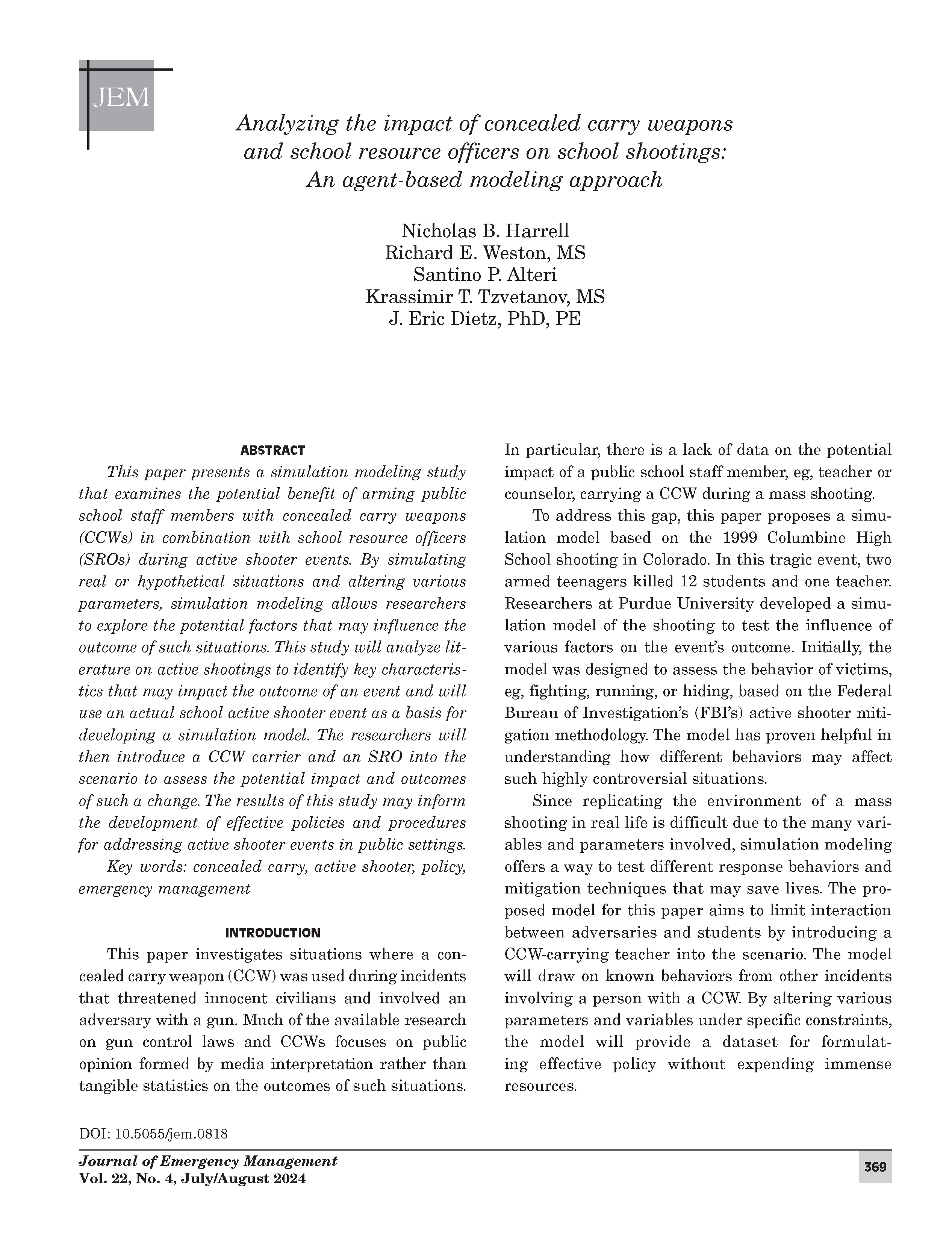Analyzing the impact of concealed carry weapons and school resource officers on school shootings: An agent-based modeling approach
DOI:
https://doi.org/10.5055/jem.0818Keywords:
concealed carry, active shooter, policy, emergency managementAbstract
This paper presents a simulation modeling study that examines the potential benefit of arming public school staff members with concealed carry weapons (CCWs) in combination with school resource officers (SROs) during active shooter events. By simulating real or hypothetical situations and altering various parameters, simulation modeling allows researchers to explore the potential factors that may influence the outcome of such situations. This study will analyze literature on active shootings to identify key characteristics that may impact the outcome of an event and will use an actual school active shooter event as a basis for developing a simulation model. The researchers will then introduce a CCW carrier and an SRO into the scenario to assess the potential impact and outcomes of such a change. The results of this study may inform the development of effective policies and procedures for addressing active shooter events in public settings.
References
Blair JP, Schweit KW: A study of active shooter incidents in the United States between 2000 and 2013. Texas State University and Federal Bureau of Investigation. 2014. Available at https://www.fbi.gov/file-repository/active-shooter-study-2000-2013-1.pdf/view. Accessed December 19, 2022.
Blair JP, Schweit KW: Active shooter incidents in the United States in 2020. Federal Bureau of Investigations. 2021. Available at https://www.fbi.gov/file-repository/active-shooter-incidents-in-theus-2020-070121.pdf/view. Accessed December 19, 2022.
Blair JP, Schweit KW: Active shooter incidents in the United States in 2021. Texas State University and Federal Bureau of Investigations. 2022. Available at https://www.fbi.gov/file-repository/active-shooter-incidents-in-the-us-2021-052422.pdf/view. Accessed December 19, 2022.
Anklam CE, Kirby A, Sharevski F, et al.: Mitigating active shooter impact: Analysis for policy options based on agent/computer based modeling. Emerg Manag 2014; 13(3): 1-24. Available at https://foacpac.org/uploads/Reports-Studies/2014-09-Dealing_With_Active_Shooters-Purdue_Research_Paper-Compr.pdf. Accessed December 19, 2022.
UNODA: How to establish and maintain gun-free zones. 2014. Available at https://www.un.org/disarmament. Accessed December 22, 2022.
Blair JP, Schweit KW: Active shooter incidents in the United States in 2019. Federal Bureau of Investigations. 2020. Available at https://www.fbi.gov/file-repository/active-shooter-incidents-in-theus-2019-042820.pdf/view. Accessed December 19, 2022.
Bronars SG, Lott Jr. J: Criminal deterrence, geographic spillovers, and the right to carry concealed handguns. Am Econ Rev. 1998; 88(2): 475-479.
Lott Jr. JR, Mustard DB: Crime, deterrence, and right-to-carry concealed handgun laws. J Legal Stud. 1997; 26(1): 1-68. DOI: https://doi.org/10.1086/467988
Wegenka JA: Concealed handgun laws in the United States. 2017. Western Kentucky University. Available at https://people.wku.edu/brian.goff/e596%20wegenka.pdf. Accessed December 22, 2022.
Auten JH: Response time—What’s the rush. Law Order 1981; 29(11): 24-27, 29. Available at https://www.ojp.gov/ncjrs/virtuallibrary/abstracts/response-time-whats-rush#:~:text=Several%20studies%20have%20established%20that,drops%20to%20approximately%2020. Accessed December 19, 2022.
Buster C: Patrol response challenge. NCJRS Law Order. 2008; 56(6): 62-68. Available at https://www.ojp.gov/ncjrs/virtual-library/abstracts/patrol-response-challenge. Accessed December 19, 2022.
Hoyer M: NRA plan would change security in most schools. USA Today. December 22, 2012. Available at https://www.usatoday.com/story/news/nation/2012/12/21/nra-newtown-police-inschools/1784953/. Accessed August 1, 2022.
Schenke J: Research reveals ways to stem growing active shooter tide. Purdue University. 2014. Available at https://www.usatoday.com/story/news/nation/2012/12/21/nra-newtown-police-inschools/1784953/. Accessed July 25, 2022.
Hutchinson A: Report of the national school shield task force. National School Shield. 2013. Available at https://www.edsource.org/wpcontent/uploads/old/NSS_Final.pdf. Accessed December 22, 2022.
Avila M: The school guardian program. Florida Department of Law Enforcement. 2019. Available at http://www.fdle.state.fl.us/FCJEI/Programs/SLP/SLP-Papers-by-Author.aspx. Accessed December 19, 2022.
Judd G: Polk county school safety guardian program—A partnership that works. All Points Bull. 2018; 28(3, summer): 14-15. Available at http://trendmag.trendoffset.com/publication/?i=543002&article_id=3239038&view=artileBrowser&ver=html5. Accessed December 19, 2022.
Kent JK, Curran FC: Pulling the trigger: The decision of arming school staff in a large, diverse school district. J Cases Educ Leadersh. 2021; 24(3): 87-104. Available at https://journals.sagepub.com/home/jel. Accessed December 19, 2022. DOI: https://doi.org/10.1177/1555458921993193
Jonson CL, Burton AL, Cullen FT, et al.: An apple in one hand, a gun in the other: Public support for arming our nation’s schools. Criminol Public Policy. 2020; 20(2). Available at https://onlinelibrary.wiley.com/doi/pdfdirect/10.1111/1745-9133.12538. Accessed December 19, 2022. DOI: https://doi.org/10.1111/1745-9133.12538
Schildkraut J, Martaindale MH: Should firearms be allowed in K-12 public schools? An analysis of law enforcement’s perceptions of armed teacher policies. Secur J. 2022; 35: 1288-1307. DOI: https://doi.org/10.1057/s41284-022-00327-4
Givens A: Missing the mark: School personnel should not be armed. Univ Dayton Law Rev. 2015; 40(2): 201-224. Available at https://heinonline.org/HOL/Page?handle=hein.journals/udlr40&div=13&g_sent=1&casa_token=. Accessed December 19, 2022.
Waldrop T: What we know about the armed bystander who killed the shooter at an Indiana mall. CNN. December 19, 2022. Available at https://www.cnn.com/2022/07/19/us/eli-dicken-indiana-mall-shooting-bystander/index.html. Accessed December 19, 2022.
Kirby AM: Comparing Policy Decisions for Active Shooters Using Simulation Modeling (Publication No. 10149736). [Doctoral dissertation, Purdue University]. 2016. ProQuest Dissertations Publishing.
Lewinski WJ, Avery R, Dysterheft J, et al.: The real risks during deadly police shootouts: Accuracy of the naive shooter. Int J Police Sci Manag. 2015; 17(2): 117-127. DOI: https://doi.org/10.1177/1461355715582975
Lee JY, Dietz JE: Assessing the effectiveness of an automatic door lock system by discharge detection to lower casualties during an academic active shooter incident. Int J Eng Res Innov. 2019; 11(1): 46-52.
Cesario J, Johnson DJ, Terrill W: Is there evidence of racial disparity in police use of deadly force? Analyses of officer-involved fatal shootings in 2015–2016. Soc Psychol Personal Sci. 2019; 10(5): 586-595. DOI: https://doi.org/10.1177/1948550618775108
FBI: Police response time to active shooter attacks. FBI. 2017. Available at https://leb.fbi.gov/image-repository/police-response-timeto-active-shooter-attacks.jpg/view. Accessed December 19, 2022.
Reiff G, Dixon W, Jacoby D, et al.: The president council on physical fitness and sports 1985. National School Population Fitness Survey. 1986. Available at https://eric.ed.gov/?id=ED291714. Accessed December 22, 2022.

Published
How to Cite
Issue
Section
License
Copyright 2007-2025, Weston Medical Publishing, LLC and Journal of Emergency Management. All Rights Reserved.





